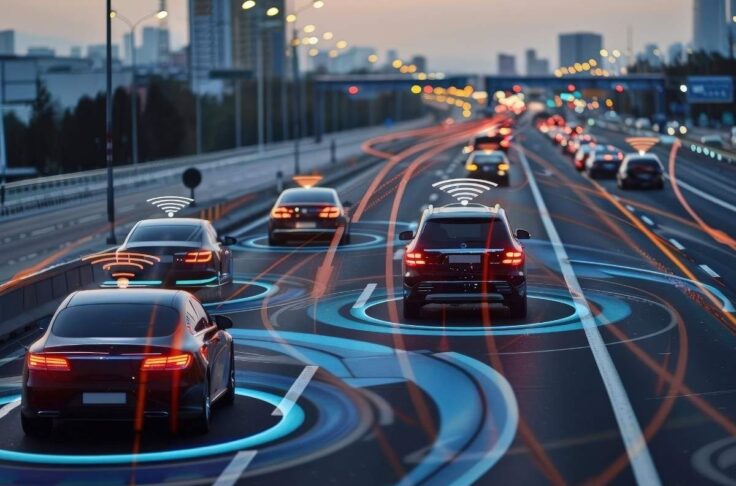Microcars in Carsharing: Why Size Matters
Summary and table of content
There are a growing number of microcars available on the market, and it’s just a matter of time before we see them in more shared mobility services. Microcars play a role in being a lightweight, electric-driven way to get around with the comforts of a regular car. While there are key aspects to consider when building future microcars, there is definitely potential to this form factor.

Shared vehicles have evolved over the years to include more than just cars – shared mopeds, scooters, and bikes are commonly found on streets in cities of all sizes. Gaining traction most recently has been the sharing of microcars. Unlike their full-sized counterparts, microcars typically weigh under 500 kg and have a maximum 2-passenger capacity. This lighter footprint enables these cars to be electric-powered, adding another option to the sustainable mobility mix.
Are microcars new? Not in the least. While it likely wouldn’t have been considered a microcar back then, one of the first cars that reflect what we would call a microcar today is the BMW Isetta. Launched after World War II, the BMW Isetta was the complete car that people could buy if they couldn’t afford BMW’s more premium cars. It was also BMW’s way of introducing individual mobility to the masses. Fast forward to today and the BMW Isetta’s iconic design has inspired the look of current microcars like the Microlino from Switzerland.
Variants of microcars
As with any new form of mobility, there are many buzzwords that are used to categorize the variations currently available on the microcar market. Generally, the distinguishing features of microcars are the weight of 500 kg, putting them in the category of micromobility. We see microcars fitting in between electric cars and electric mopeds on the mobility spectrum. Even then, there can be a lot of variation in terms of what such a car looks like or is categorized by. Some other terms that may be used to describe a microcar include:
- Light quadricycles – Light quadricycle is a classification used in Europe for vehicles that have four wheels and that do not weigh more than 425 kg, and do not go faster than 45 km/h.
- Neighbourhood electric vehicles (NEV) – Neighbourhood electric vehicles is the category used in the United States for vehicles that do not go faster than 25 mi/h (40 km/h) and weigh less than 1,400 kg. NEVs are often restricted to streets whose speed limit is 30 mi/h, meaning they are not legally allowed to go on faster thoroughfares and highways.
- Pod cars – The future of microcars are pod cars. Futurists see pod cars as being autonomous vehicles that provide point-to-point transportation for two to ten people, with ample room inside for passengers to relax and enjoy the comforts of the ride.
Why microcars?
As its name suggests, a microcar is a super small car. Even though traditional OEMs have been creating bigger and bigger cars, microcars have its benefits. One of the main contributors to city congestion is the number of single-occupancy vehicles on the road. These small cars give people the similar comforts of a standard car by providing a sheltered and sometimes heated space that keeps them protected from wind and rain but takes up less space because there isn’t any wasted seats or cargo capacity. In addition, its compact size means it requires less space for parking. As a result, microcars combine the positive features of cars with the advantages of micromobility vehicles, bringing an optimized, more agile form factor for consumers.
More companies and entrepreneurs are recognizing these advantages of microcars. In 2021, Citroen announced that its brand-new Ami will be supplemented by the My Ami Cargo, a commercial vehicle that comes with a loading volume of 400 liters and payload of 140kg. Arcimoto, a microcar-focused manufacturer founded in 2007, offers local delivery vehicles and a customized solution for local rescue and emergency forces called Rapid Responder.
While not a true microcar according to the above-mentioned definition, the former car2go’s Smart ForTwo vehicles highlighted the benefits of a smaller than usual car. The shared cars were small enough to be parked perpendicular to the sidewalk, making parking much easier to find. Although road traffic regulations in some European countries like Germany did not explicitly allow this type of parking, many drivers in crowded cities still take advantage of this type of parking. In North America, car2go worked with commercial property owners to allocate dedicated parking for the Smart ForTwo in spaces that would otherwise not be used.

This flexibility has led to microcars being adopted for use within urban areas. Pikyrent uses Citroen’s Ami in the Italian city of Bari to supplement their mopedsharing fleet. Considered a quadricycle in Europe, the Citroen Ami gives carshare users the ability to zip around urban areas more easily.
The growth of microcars can also be found on a smaller, local scale as well. In the United States, golf-cart like vehicles are considered personal transport vehicles, with sales doubling since the pandemic began. These person transport vehicles aren’t being used by golfers, but instead young people and families looking for ways to get around their neighborhood. In China, microcars are popular among migrant workers due to its low price tag. The adoption of the Hongguang Mini electric microcar has literally exploded, resulting in monthly sales outnumbering Tesla sales.
Aside from personal transportation, microcars can be used in last mile parcel and food deliveries. Due to the steady growth of e-commerce sales, an increase in parcel deliveries worldwide, and more demand for food delivery services from the pandemic, cities are looking for a solution to combat the increase of delivery vehicles on the road. To help mitigate further congestion, last mile delivery services are exploring new ways of transportation that fit to the local mobility culture. For example, UPS has been using e-tricycles for parcel deliveries for several years now, and even though these tricycles have a wind shield, they do not provide the same protection as a fully enclosed car. This is why microcars make sense as an all-weather option for parcel delivery and food delivery services.
White paper on microcars in European carsharing
Access curated insights, learnings from carsharing operators and stakeholders, and the latest market data on microcars.
Aspects to consider for future microcars
The size of microcars means that, within the mobility ecosystem, they can address inter-urban trip needs sustainably. They go fast enough (or slow enough, depending on how your perspective) to be safe for residential streets and downtown cores. Their electric motor allows for quick acceleration, which means they do not disrupt the flow of traffic. Microcars also do not carry around excess weight in material or capacity, meaning they efficiently consume energy. From a cost perspective, they are more expensive than a moped but cheaper than a car.
For shared mobility operators, this means being able to offer a lower rental price for shared microcars, which can lead to increasing the adoption of carsharing among price-sensitive customers. Special parking rules can also. In addition, they can contribute to the penetration of younger customer groups due to their special status in local transport regulations. In theory, shared mobility operators can use microcars to get people using their service without needing a driver’s license. For example, in France, you can drive a Citroen Ami starting at the age of 14.
These are great benefits to kick-start the growth and adoption for this modest form of mobility, but improvements to the vehicles need to be made to help them reach the critical mass. In shared mobility, there have been a handful of operators who have attempted to offer microcars as a mobility solution. Renault’s Twizy was used in Totem, Twizy Way, and Scoot Networks, but further adoption of these vehicles has stalled due to lack of consumer adoption. Common concerns about microcars include safety, vehicle design, and regulations.
- Safety – Since microcars are driven on the road besides standard cars, safety is a top concern to protect the drivers. Whether this involves a stronger vehicle frame and adding airbags to protect the driver from collision or building better suspension to keep the driver in control when going over potholes, there are areas of improvement.
- Regulations – To support improving the maturity and robustness of microcars, it will be necessary to have more regulations to mandate safety requirements. Many of these cars are considered legal motorized vehicles, but they lack the standardization and regulations that car manufacturers must adhere to. In addition, some microcars do not require a driver’s license. In Beijing, sales of microcars are banned due to a lack of regulation, though they can still be seen driving throughout the streets due to minimal enforcement.
- Vehicle design – While a rational consumer will choose the vehicle that is most suitable for them based on need, often times, what a vehicle looks like plays a role in attracting consumers. People have to want to ride these microcars, so it must reflect the lifestyle they are trying to achieve. In addition, the vehicle design needs to be considered in the context of vandalism. The vehicles are open concept meaning the interiors can be vandalized, and given their relative lightweight, have been found destroyed in rivers.

Building microcars for sharing
It is important to consider the factors that will go into making a suitable shared microcar. Ideally, microcars do not follow the same progression as kick scooters, where they were introduced to the market with durability that could not stand up to high utilization. Having purpose-built microcars designed for sharing is ideal for a seamless, reliable customer experience. Based on discussions with INVERS engineers and their unique expertise from analyzing more than 650 vehicle models, including microcars, these are some key features every shared microcar should have:
- Central lock system – One challenge for microcars in the sharing context has been a lack of a central lock, which means users would not be able to lock and unlock the microcar via the app. In a typical carsharing model, a central lock is critical to ensuring the vehicle is only used for an authorized rental and to prevent theft. This would also reduce vehicle turnover and keep operational costs low.
- Standardized charging – To be a sustainable mobility solution, a microcar must be electric. At the same time, the vehicles should be compatible with existing charging infrastructure and/or have swappable batteries. Otherwise, shared microcars are limited to the station-based model. While range likely is not too big of a concern, these features will ensure that an electric microcar will be known as a suitable mobility option for mid-distanced trips.
- More CANbus signals – Data is becoming more and more of a critical aspect of successfully scaling shared mobility options. Having insight into vehicle data is important for understanding how people are using the service. Most microcars we have analyzed have limited CANbus signals, meaning there is no information on vehicle lock status, battery level, state of charge, etc. Without this data, a fleet manager is virtually blind to the maintenance needs of the vehicles.
Getting prepared for the future
Overall, microcars have the potential to evolve into a viable mode of transportation. Its adoption is still in the early stages, but it is never too early for future operators of shared microcars to consider the factors that will contribute to a successful mobility service. If you’re curious to learn more, we’d be happy to talk with you about sharing microcars and getting them equipped with our market-leading connectivity and telematics solutions.


